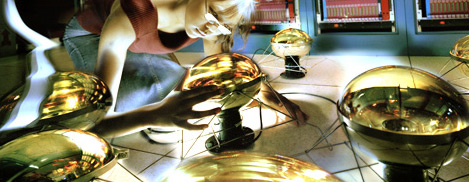Intensity Frontier
MiniBooNE
Researchers initiated the Booster Neutrino Experiment, BooNE, to verify definitively the results of the Los Alamos Liquid Scintillator Neutrino Detector experiment. In 1995, the Los Alamos experiment presented strong evidence for the oscillation of muon anti-neutrinos into electron anti-neutrinos.

The 800-ton detector, called MiniBooNE, searches for neutrino oscillations. The detector is located 500 meters from Fermilab's second neutrino source, the Booster Neutrino Beam or BNB.
The presence of neutrinos can only be inferred by detecting the charged particles they produce when they collide and interact with matter. By characterizing the resulting product particles through measuring their charge and energy, physicists can trace back and characterize the incoming neutrino.
MiniBooNE has ruled out the Los Alamos result, but what remains is an excess of low energy interactions that may be significant but do not fit within the current physics model.
The MiniBooNE collaboration also explores physics topics from the fundamental understanding of neutrino interaction probabilities to more exotic matters, such as neutrinos from supernovae and the neutrino magnetic moment. Next, the MiniBooNE collaboration plans to search for CP Violation by looking for a difference between neutrino oscillations and antineutrino oscillations.


